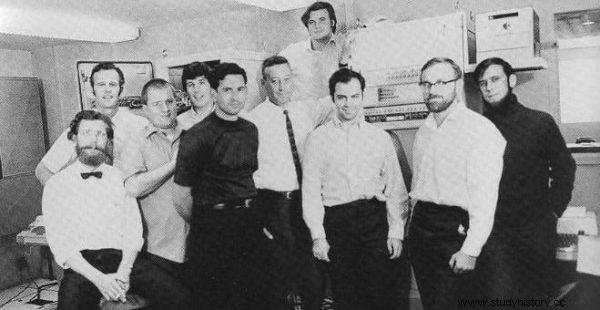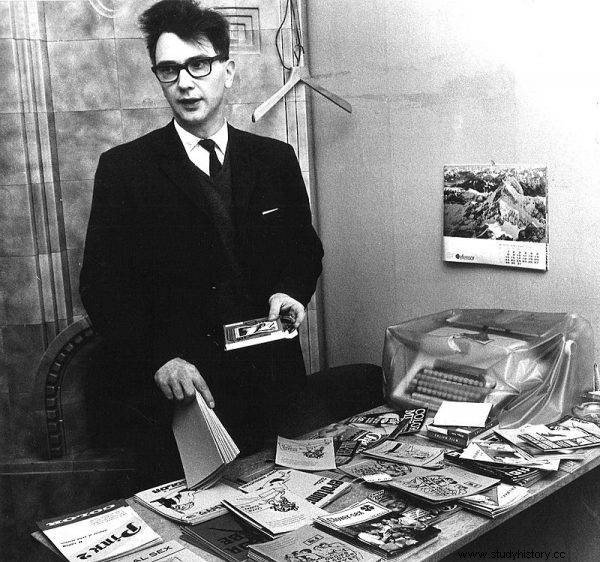The Internet was supposed to be developed for military purposes. So how did it happen that it became an inseparable part of our lives, and by the way ... the kingdom of pornography?
Postcards for adults, sneaking through colorful newspapers, playing at night cassettes. Late evenings with pay-per-view satellite channels on which erotic programs were broadcast every hour. Special cinema screenings. This was all before porn could be hosted. And years later - a few clicks and millions of materials to choose from. " Sex ”Is the most frequently entered term in search engines. And pornography itself hit the web ... probably before the official start The Internet.
First forums? They looked like elephants with diarrhea
Like many of our everyday amenities, the Internet was to be built for military purposes. The concept itself was described by Paul Baran - on behalf of the American Armed Forces. The Soviet Union had recently launched the first Sputnik into orbit, and the world was haunted by the specter of World War III.
The network project was called ARPANET. The first computers of California research centers were connected in 1969. Two years later, Raymond Tomlinson sent the first ever email and applied the "@" sign . In the 1980s, the system became the standard for all military networks, and it was withdrawn from service in 1990. Mainly due to the Internet, developed by private companies. However, before that happened, among ARPANET users there were two systems:BBS which acted as a bulletin board and a very similar Usenet being de facto the prototype of internet forums.

Members of the IPM team working on improving the ARPANET network (from left):Truett Thatch, Bill Bartell (Honeywell), Dave Walden, Jim Geisman, Robert Kahn, Frank Heart, Ben Barker, Marty Thorpe, Will Crowther, Severo Ornstein
What could be found there? Eugene Howard Spafford, a scientist working on the development of the web, summed up Usenet in 1992 as:"(...) a herd of elephants with diarrhea. Massive, hard to redirect, inspiring, fun and delivering a staggering amount of excrement when you least expect it. The content available there included, among others ASCII porn - the first form of online pornography.
Dots, dashes and ... first payments
Where did this and not another format come from? First of all, due to the poor bandwidth of the link. In the 1980s, data could be transferred between American supercomputers at 56 kbit / s . This value grew year by year. Even so, the road to freely downloading photos and videos was still a long one. The second advantage was the universality of ASCII - the standard character set could be easily seen even on devices unable to display digital images. You could also print them. Any sufficiently determined user of BBS and Usenet could share and receive pornography in ASCII format.
Sex then settled on the web and never left it again. The new invention turned out to be the answer to the biggest problem of producers from the "pink industry" - delivering the product to customers. Almost everyone wanted to remain anonymous. But before companies became interested in Usenet, users traded private collections on their own. And these contained all kinds of specimens. Also more niche than the popular big breasts and schoolgirl outfits. No personal data - only nicknames were revealed. Some people shared the materials for free, others found a way to earn money. The first preconfigured payment gateways used in the network were used to collect money for porn material. All this before official browsers were created.

The new invention turned out to be a response to the biggest problem of producers from the "pink industry" - supplying the product to customers
At the beginning of the 90s, the Internet becomes widely used, permanently replacing ARPANET. Tim Berners-Lee creates the first page explaining what the World Wide Web is and how it works . The network is developing not only at universities and military units, but also in the homes of private users. Just ASCII porn instead, it becomes a niche retrofit of the past decade.
"Sex is the most important thing in the world"
Or at least Brian McNair wrote that. We can agree or disagree with the sociologist, but it cannot be denied that pornography drives the development of technology. When it comes to online content, this is primarily about access and payment verification. Electronic Cards Systems was founded in 1990 and the founder Richard Gordon initially worked primarily with the adult industry . Porn videos made it possible to improve the distribution of online goods. The largest online shopping platforms such as Amazon and eBay did not start appearing until a few years later. Earlier, Electronic Card Systems earned mainly from cooperation with such parties as ClubLove, which released, among others the famous six-tape of Pamela Anderson and Tommy Lee.

Like many of our everyday amenities, the Internet was going to be built for military purposes.
As for the verification - it was closely related to the payment. The key was the credit card. In 1996, the US government approved the document as an age verification tool. By requiring card payments, pornography providers solved the problem of access by minors. For obvious reasons, it was not an ideal solution. Actually, it only worked for paid material - before the dissemination of amateur films.
But before that, at the turn of the 21st century, it was possible for several companies to provide pornography to consumers. Among them:Adult Check, CyberAge, CCBill and Internet Billing Co. They acted as intermediaries between banks and producers. And every time someone paid for spicy recordings, probably one of those companies had a share of it. And just refining the payment system was the last step the porn industry needed to conquer the internet.
Sources:
- Crocker S., Arpanet and Its Evolution - A Report Card, "IEEE Communications Magazine" 59 (12), 2021.
- Jackson C., From ASCII to streaming video:How the Internet created a multi-billion dollar porn industry, www.thenextweb.com [accessed:10/02/2022].
- McNair B., Sex, democratization of desire and the media, or the culture of exposing, Warsaw 2004.
- Mey K., Art and Obscenity , Bloomsbury 2007.
